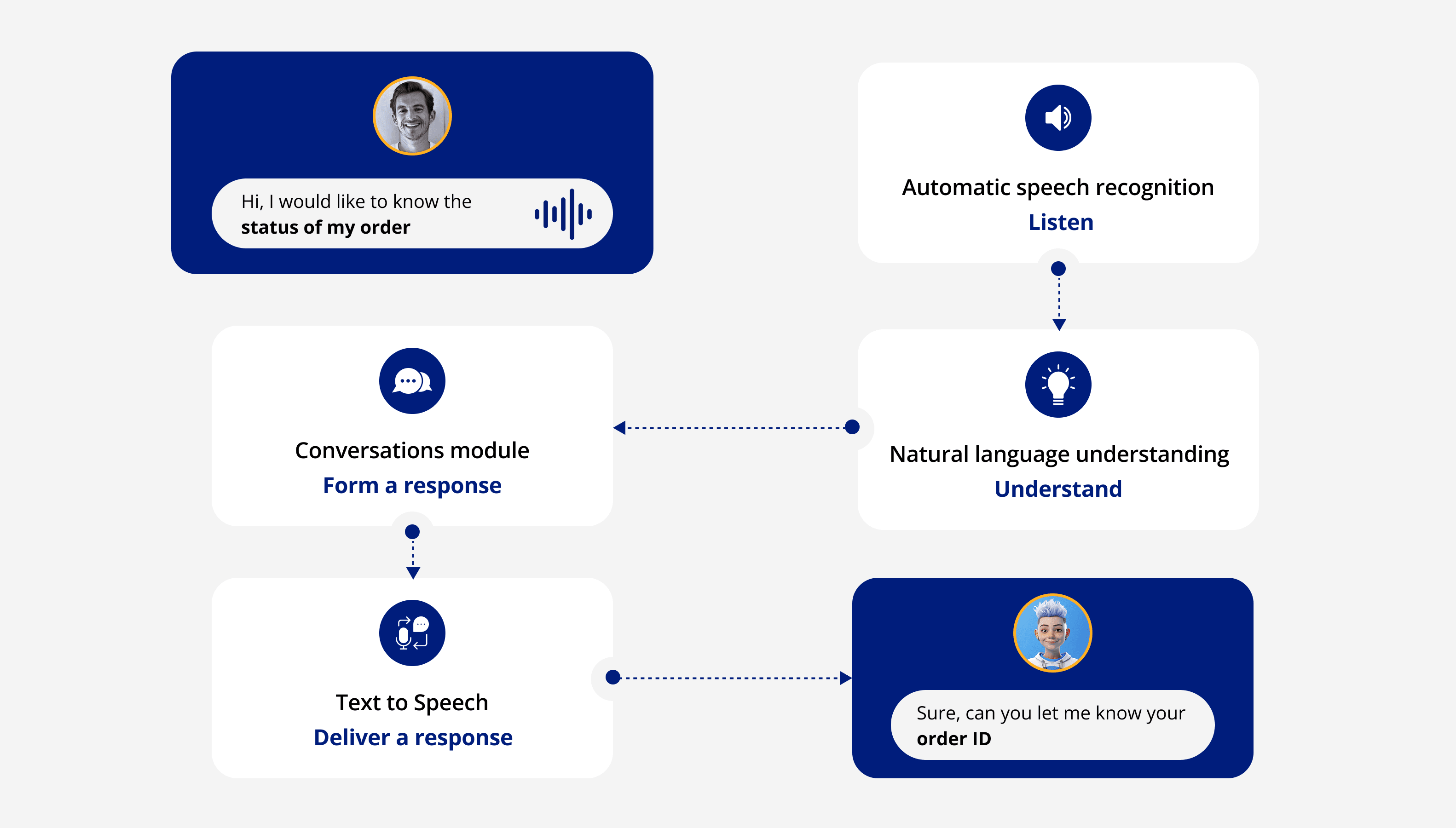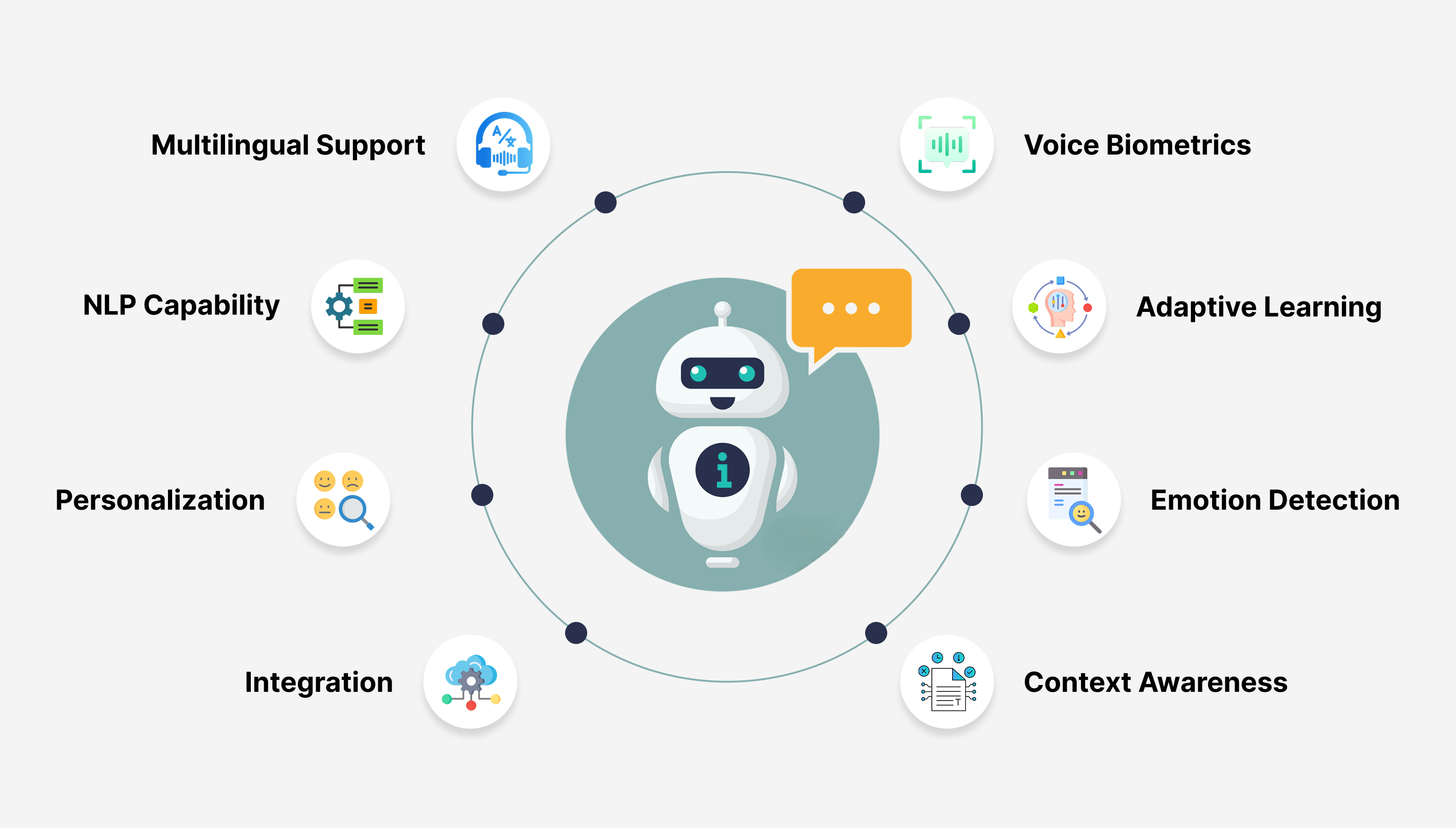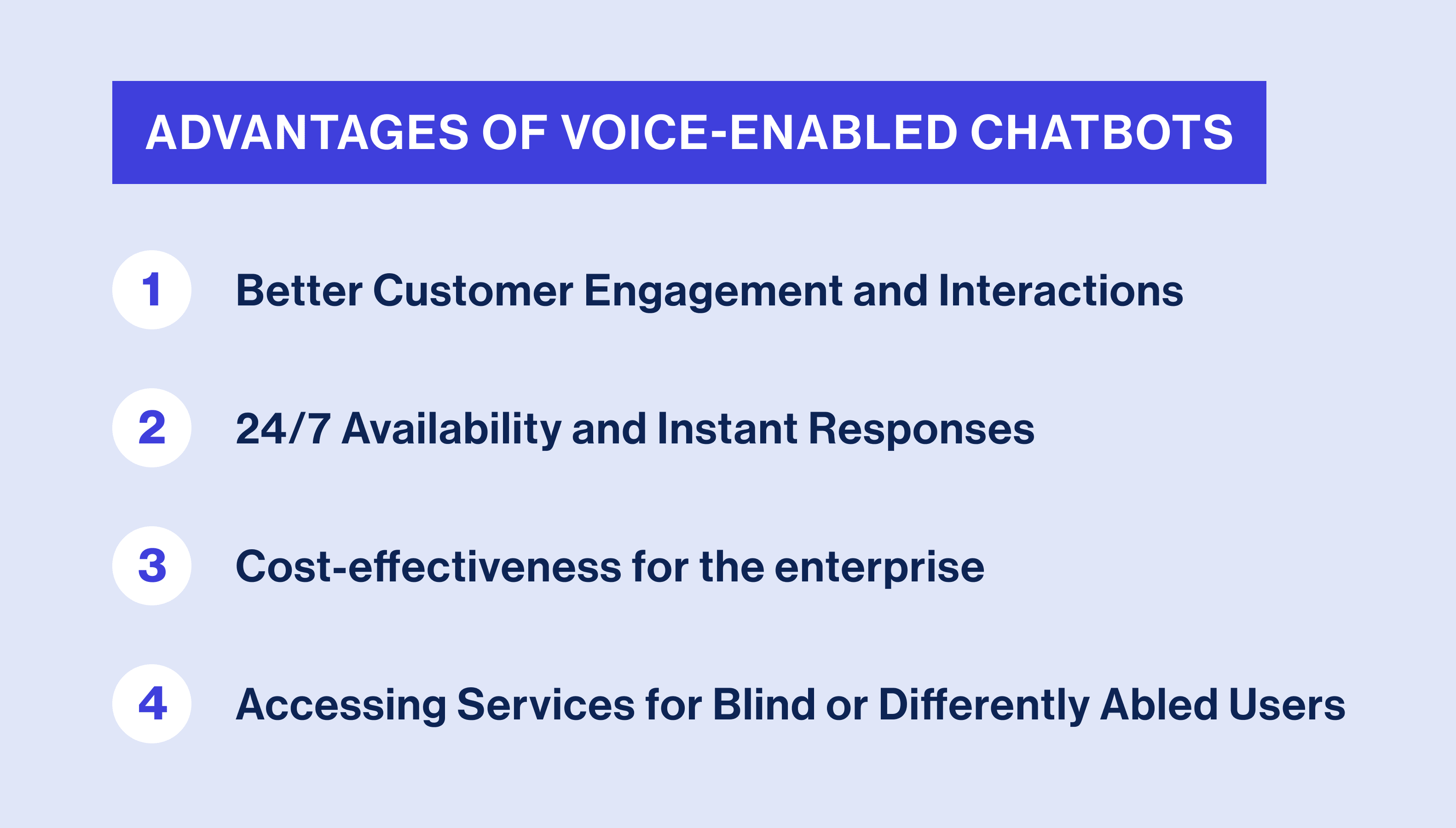AI/ML
Voice-Enabled Chatbots: The Future of Customer Interaction
Written ByYash Vibhandik
CEO, Bitontree
Published:2 April 2025
25 minutes read

Imagine a world where customers can interact with businesses on voice commands alone. No typing. No more waiting around. Just a command or two, and the speech recognition chatbot understands, responds, and fixes problems with immediate effect. This is basically how voice chatbots are revolutionizing customer interactions by making them faster, totally natural, and extremely easy to engage with.
Today, one of the key elements of daily life is voice technology, thanks to smart assistants like Alexa, Siri, and Google Assistant. It is reported that more than 48% of customers use voice search daily. Chatbot with voice recognition implements a seamless environment for customers to engage with businesses in a hands-free manner, leading to better customer satisfaction and engagement.
Today, quick and effortless interaction is what customers expect. Informationally, traditional chatbots have gained considerable mileage toward enhancing service speed, but they still require manual user input. In contrast, voice assistant chatbot take it further by utilizing natural language processing (NLP) and AI-based speech recognition to communicate with the level of understanding and response of a human. This technology is defining the future of customer service, e-commerce, and user engagement.
Voice chatbots keep operational processes simple and improve user experiences for their interaction-based services: answering inquiries, booking appointments, or even completing transactions. Hence, companies that capitalize on this incoming innovation have a great advantage, leading to faster response times and better customer relations. So, is your business ready for the future of voice-driven interactions? Let’s find out.
Understanding Voice-Enabled Chatbots
Voice chatbots use artificial intelligence and voice recognition to hear and recognize spoken commands. They allow hands-free, real-time interactions with both parties. By 2026, voice AI will drive $19.4 billion in transactions. They help in customer support bookings and sales at the same time making the experience faster and more natural than the traditional ways of text chatbots.
Voice-Enabled Chatbots: How do they work?

Voice-enabled chatbots use artificial intelligence to enable user interaction with companies via voice commands instead of text. Voice-enabled chatbot improves customer service by automating requests while giving the user a hands-free interactive experience. These are integrated into several platforms such as websites, mobile apps, smart speakers, and call centres offering multi-language support, real-time assistance, and conversations tailored to individual client needs via customer history and behaviour.
This is how a voice chatbot works:
-
Speech Recognition (ASR): The spoken words are converted into text using AI-based speech-to-text algorithms. Background noise is filtered, while speech clarity is enhanced for accurate transcription.
-
Natural Language Processing (NLP): Analyzes user intent, sentiment, and context. NLP models such as BERT or GPT enable the chatbot to grasp different accents, slang, and the complexity of the query.
-
AI-Powered Decisioning: Machine-learning algorithms evaluate input to extract relevant information and provide the chatbot with the most advantageous response. Advanced chatbots have pre-trained AI models that will detect what the user really wants.
-
Text-to-Speech (TTS) Conversion: Using synthetic voice engines, like Google’s WaveNet or Amazon Polly, responses are further converted back into human-like speech.
-
API and Backend Integrations: Chatbots hook into CRMs, databases, and third-party applications to pull in personalized user information and perform more complex requests.
-
Continuous Learning and Adaptation: The chatbot improves over time using ML continually and refines its responses according to user interaction.
Voice-Enabled Chatbots and Traditional Chatbots: How they Differ?
Voice-enabled chatbots and traditional ones do the same thing with clients; however, the two differ in the way they typically use input to give results or responses. Traditional chatbots are based on NLP and text-based algorithms, while those integrated with voice use Automatic Speech Recognition, Text-to-Speech, and Speech Synthesis for voice communication. Below is a detailed comparison:
| Feature | Traditional Chatbots | Voice-Enabled Chatbots |
|---|---|---|
| Input Method | Text input via keyboard | Voice commands processed through ASR (Automatic Speech Recognition) |
| Technology Used | NLP (Natural Language Processing), ML (Machine Learning) | ASR, NLP, TTS (Text-to-Speech), AI-driven Speech Processing |
| Response Format | Text-based replies | Spoken responses using TTS and Speech Synthesis |
| User Interaction | Requires manual typing and reading | Hands-free, real-time voice communication |
| Latency | Low latency, but requires user reading time | Lower latency, as spoken responses are faster |
| Use Cases | Website chat, social media, apps | Call centres, IVR (Interactive Voice Response) systems, virtual assistants |
| Accessibility | Limited to text-literate users | More inclusive, supports visually impaired and differently-abled users |
| Integration | Chat interfaces, messaging apps | Smart speakers, mobile assistants, IoT devices |
The Role of Voice-Enabled Chatbots in Modern Business
Voice chatbots are redefining business communications by rendering an effortless and hands-free support mechanism and automating customer interactions. Research indicates that 71% of consumers would rather use voice assistants for instantaneous responses. Here is how they help in modern business operations:
-
Instant, Hands-Free Support: These voice chatbots, using Automatic Speech Recognition (ASR) and Natural Language Understanding (NLU), allow robots to convert and process a voice query into the same application in real time and provide instant communication without any manual intervention.
-
Automating Repetitive Tasks: These AI-powered chatbots require due human intervention by machine learning algorithms for FAQs, scheduling appointments, processing transactions, and call routing.
-
Personalized Customer Experience: Sentiment analysis and context-aware AI build avatar technology that monitors user interaction, analyses emotion, and personalizes response depending on previous interactions.
-
Seamless Integration: Using APIs and cloud-based services, voice chatbots link with CRM, ERP, and IoT devices so that data can flow in and out, thereby increasing operational efficiency.
-
Enhanced Multilingual Support: Multimodal AI models and speech synthesis technologies (TTS - Text-to-Speech) allow the chatbot to converse in multiple languages and aid in global customer engagement.
-
Data-Driven Insights: Artificial intelligence-enabled analytics tools such as speech-to-text transcription and behavioral analysis provide enterprises with the necessary tools to understand user patterns, increase chatbot accuracy, and enhance their service strategies.
Why Voice-Enabled Chatbots Are the Future of Customer Interaction?

Voice-enabled chatbots are also likely to be important customer contact tools as businesses incorporate AI voice solutions to supplement traditional channels. The worldwide voice assistant market is expected to amount to $11.2 billion by 2026. Here are some reasons why voice-based chatbots mold the future:
Adoption of Voice Assistants Increased
At present, there are 300 million smart speakers present around the globe. As voice-based assistants such as Amazon Alexa, Google Assistant, and Siri started being in demand, they initiated a wave of abstract requirements for conversational AI in customer service. In comparison to only speech recognition (ASR), most voice-based chatbots include speech synthesis (TTS) in their interactive features to support human-like conversation.
Natural and Hands-free Communication
Voice processing AI sees the line between text chat and real-time voice communication dissolve, which creates a speedier, seamless avenue for interaction for disabled users or users without enough technical or accessible know-how.
Sophisticated Natural Language Understanding
Deep-learning neural networks permit advanced understanding of natural language by using AI-based semantic analysis that enables processing intentions, accent recognition, and contextually relevant responses.
Integration to IoT and Smart Devices
Hands-free control of smart appliances, home automation, and enterprise applications would provide a voice-enabled AI system linked up with IoT platform systems.
Hyper-personalization offered through AI & ML
Voice chatbots personalize the outreach further on user preference through predictive analytics and sentiment analysis, hence increasing engagement as well as customer loyalty.
Prompt Response Time and Efficiency
With the control of voice commands locally instead of relying significantly on cloud storage for the processing of a command, Edge AI brings down latency to increase efficiency and speed in interaction.
Key Features of Voice-Enabled Chatbots

Voice-enabled chatbots utilize AI-based speech recognition and machine learning to create naturally flowing conversations in context. They mix advanced algorithms with cloud computing and deep neural networks to personalize the experience further. The following are their key features:
-
NLP Capability: The solutions apply various Natural Language Processing (NLP) models such as BERT or GPT that process voice input, evaluate intent, and give human-like responses.
-
Multilingual Support: Speech-to-text (STT) and text-to-speech (TTS) models can be deployed in various foreign languages to facilitate smooth communication across the globe.
-
Personalization: The design allows AI-driven sentiment analysis and predictive analytics to focus on customizing responses according to how the user behaves with and reacts toward the dialogue system.
-
Integration: Interfaces with other applications/functionalities such as CRM, IoT ERP, and cloud platforms to automate workflows, control smart devices, and synchronize databases.
-
Context Awareness: Remembers past dialogue using session memory and dialogue management for relevant and continuous interactions.
-
Emotion Detection: Based on analysis of voice modulation, with the aid of deep learning classifiers, it tries to decipher the emotional state of the user and responds accordingly.
-
Adaptive Learning: Employs reinforcement learning (RL) and self-learning algorithms to add to the accuracy with time.
-
Voice Biometrics: Voice recognition and authentication powered by AI provides a secure and frictionless user verification system.
-
Customizable Wake Words: Supports an AI-based keyword spotting (KWS) system for chatbot activation by voice commands personalized to the user.
Industry-Specific Applications of AI Chatbots
AI-empowered voice chatbots are redefining worlds to automate processes, make the customer experience better, and further improve in productivity. Juniper Research estimates that by 2025, AI chatbots will handle 75% of customer interactions, effectively cutting business costs by around $11 billion a year.
They use them in different industries as follows:
- E-commerce
AI chatbots can become an integral part of your website in different ways. For instance, an AI-powered chatbot on the website can help customers navigate through the website and the products.
When customer browses through your website and explore the products, they have a lot of questions brewing in their mind. While your website has a comprehensive knowledge base, they might not spend enough time finding answers. That’s why a chatbot can help; it can fetch the data and satisfy the user’s queries regardless of the time.
Also, with the available personalized insights, AI chatbots can trigger a personalized message that directs their attention. Chatbots can encourage your visitors to spend some more time on your website, driving the engagement rates.
- Healthcare
AI-powered chatbots book and manage patient appointments, reducing administrative burden. AI models analyze symptoms through NLP-based tools (e.g., Babylon Health and Ada Health) and suggest possible conditions. AI-powered apps remind patients to take their medications on time, improving adherence to treatments. AI connects to Electronic Health Records (EHRs) while maintaining compliance with HIPAA regulations to ensure secure patient data handling.
- Banking
AI chatbots provide real-time account balance updates and spending insights. AI monitors transactions, detects unusual activity, and alerts customers of potential fraud. Voice recognition ensures secure banking transactions and account access. AI-powered engines like Erica (Bank of America) and Siri (Apple Pay) allow users to make transactions via voice commands.
- Education
AI supports learning, virtual tutoring, and student engagement. Platforms like IBM Watson Tutor provide personalized course recommendations, virtual tutoring, and adaptive learning experiences. AI chatbots answer student questions, assist with coursework, and provide instant feedback. AI tools analyze student submissions and offer automated grading and feedback.
Advantages of Voice-Enabled Chatbots

Voice-enabled chatbots have diverse benefits related to customer and business operational enhancement. Recently, a survey established that 70% of Generation Z happened to prefer voice interaction for customer service, which is why the voice is that relevant.
1.) Better Customer Engagement and Interactions
Advanced natural language processing and speech recognition technologies have been integrated into voice-activated chatbots. Such features will allow personalized, human-like conversations, raise customer satisfaction and lead them to loyalty.
2.) 24/7 Availability and Instant Responses
Unlike humans, AI voice chatbots offer nonstop, from any place and time, customer service. In reality, this provides instant answers to requests so that no waiting time is required for a customer, which adds value to the service and makes it more convenient.
3.) Cost-effectiveness for the enterprise
In-house voice-enabled chatbots cater for much of the human workload, resulting in significant savings in operational costs associated with automating the most frequently seen customer interaction areas. The savings can be transferred to human agents working on exceptions and more complicated tasks.
4.) Accessing Services for Blind or Differently Abled Users
A voice interface makes it possible for digital or other services to access the lives of the visually impaired and any other differently abled persons, thereby promoting a more extensive user base and demonstrating corporate social responsibility.
Why Your Business Needs Voice-Enabled Chatbots?
Voice-enabled chatbots are evolving the way customers interact with businesses, making it truly seamless for consumers. By 2026, an estimated 75% of US households are expected to have a smart speaker, according to Statista. Therefore, businesses must pivot to voice-first questioning in order to stay ahead in a competitive market.
1.) Staying Ahead of Competitors
Companies employing voice-enabled chatbots have a market advantage in terms of speed and personalization; AI voice assistants tend to automate inquiries, thereby minimizing response times and optimizing the user experience even more.
2.) Consumer Expectations
Consumers expect businesses to provide immediate, hands-free support. Voice chatbots increase accessibility and convenience for busy users who prefer speaking rather than typing.
3.) Driving Business Growth
Voice AI solutions that automate customer interactions cut costs, increase efficiency, and promote lead conversion. Voice chatbots offer sales, appointments, and customer engagement—resulting in higher revenue and customer retention.
Conclusion
Voice-enabled chatbots have indeed transformed customer interaction by providing immediate, hands-free, and intelligent replies, enhancing engagement, automating tasks, and personalizing experiences across industries. AI-powered technologies generate new levels of efficiency while driving downtimes in cost and giving rise to new customer expectations.
With the rising trend of voice technology adoption, incorporating voice-enabled chatbots is now a necessity, not a choice. Early adopters will gain a competitive advantage in serving their customers through continuous support and enhanced satisfaction. The time is right to use voice AI to enhance your business communication. Don't get left behind in the digital revolution—embrace voice-enabled chatbots now!
From Text to Talk – Elevate Your Customer Experience with Voice AI!
Frequently Asked Questions
They use AI-driven context tracking, intent recognition, and data retrieval mechanisms to break down complex queries into smaller parts, ensuring accurate and relevant responses.
AI-powered chatbots use Natural Language Processing (NLP) and Speech Recognition to analyze speech patterns, learn from diverse data, and improve accuracy over time, ensuring better understanding of various accents.
Yes, modern voice chatbots integrate seamlessly with CRM, ERP, and other enterprise tools to provide real-time data access, automate workflows, and improve operational efficiency.
Yes, they automate customer support, appointment scheduling, and order processing, reducing the need for human agents and significantly cutting down operational costs.



